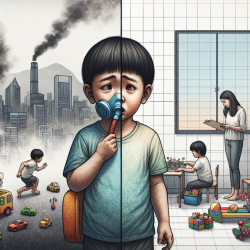Introduction
As a Special Education Director, it is crucial to stay informed about factors that influence the behavioral and cognitive development of children. A recent study titled "The Association between Exposure to Fine Particulate Air Pollution and the Trajectory of Internalizing and Externalizing Behaviors during Late Childhood and Early Adolescence: Evidence from the Adolescent Brain Cognitive Development (ABCD) Study" sheds light on how air pollution, specifically fine particulate matter (PM2.5), impacts children's mental health.
Understanding PM2.5 and Its Effects
PM2.5 refers to fine particulate matter with a diameter of 2.5 micrometers or smaller. These particles can penetrate deep into the lungs and even enter the bloodstream, potentially causing various health issues. The study investigated the association between PM2.5 exposure during late childhood (ages 9-11) and the trajectory of internalizing (e.g., anxiety, depression) and externalizing (e.g., conduct disorder) behaviors over the following three years.
Key Findings
- Higher exposure to PM2.5, particularly the number of days above the US Environmental Protection Agency (EPA) standards, was associated with increased internalizing symptoms reported by parents.
- This association was significant up to a year following exposure, suggesting that PM2.5 has a lasting impact on mental health.
- There was evidence of a sex-specific association between PM2.5 annual average exposure and externalizing symptoms, with females showing higher levels at baseline.
Implications for Practitioners
These findings highlight the importance of considering environmental factors, such as air pollution, when assessing and supporting the mental health of children. As practitioners, we can take the following steps to improve our practice:
- Advocate for policies that aim to reduce air pollution, especially around schools and residential areas.
- Incorporate environmental assessments into mental health evaluations to identify children who may be at risk due to high pollution exposure.
- Educate parents and communities about the potential impacts of air pollution on children's mental health and encourage actions to minimize exposure.
Encouraging Further Research
The study underscores the need for further research to explore the long-term effects of PM2.5 exposure on mental health and to identify potential interventions. Practitioners can contribute to this research by collaborating with academic institutions and participating in studies that aim to deepen our understanding of environmental impacts on child development.
Conclusion
By integrating the insights from this research into our practice, we can better support the mental health and development of children in our care. Understanding the environmental factors that influence behavior and mental health is essential for creating effective interventions and advocating for healthier environments.
To read the original research paper, please follow this link: The Association between Exposure to Fine Particulate Air Pollution and the Trajectory of Internalizing and Externalizing Behaviors during Late Childhood and Early Adolescence: Evidence from the Adolescent Brain Cognitive Development (ABCD) Study.










